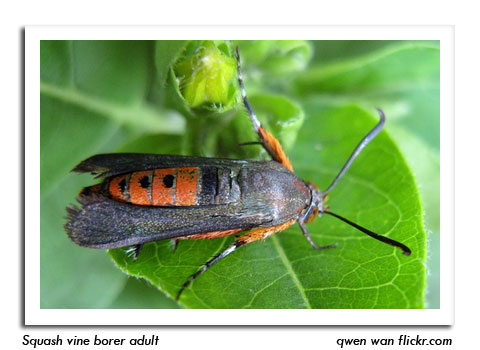
 |
|
|
Vegetables
Volume 63 Number 9 Date 06/28/2018 SQUASH VINE BORER - Continued inspection of pumpkins, squash, gourds, and other vine crops for eggs and evidence of larval feeding is advised during the next two weeks. The early- and intermediate-stage larvae are boring into squash stems and runner vines, causing plants to wilt. Insecticidal controls are only useful if applied before the larvae tunnel into vines, and reapplication may be necessary during the adult flight period. COLORADO POTATO BEETLE - The summer generation of beetles is expected to begin appearing in potatoes by early July. Pupation occurs in 7-10 days at this time of year and larval development proceeds much faster under average July temperatures. Summer beetles and all second-generation larval stages are considered damaging. FOUR-LINED PLANT BUG - Again this season, gardeners, nursery managers and vegetable growers are reporting damage to vegetables, fruits, ornamentals, flowering annuals and perennials. In most instances, four-lined plant bug feeding only affects the appearance of plants, though moderate to large populations of four-lined plant bugs can be destructive, especially to herbs. The aesthetic damage should be tolerated or ignored when possible. Contact residual insecticides are effective against plant bugs, but these broad-spectrum products also kill non-target insects and natural enemies and the pre-harvest interval may not be acceptable for herbs or other edible plants. ONION MAGGOT - Emergence of second-generation flies is anticipated near Madison, La Crosse, Spring Green and other advanced southern location in the week ahead (around 1,950 GDD simple base 40°F). Management of the summer generation is less critical than spring and fall populations since egg desiccation and mortality rates are higher at warmer temperatures, but season-long sanitation is still important for preventing future infestations. Second-brood eggs are deposited near previously-damaged onions. CABBAGE CATERPILLARS - Low to moderate infestations of diamondback moths and imported cabbageworms were observed this week in southern and western Wisconsin community gardens. The larvae of these cabbage pests feed on leaves and cause large ragged holes, eventually infesting the developing heads of broccoli, cabbage and cauliflower. Treatment thresholds are reached when 10% of cabbage in the early heading to mature head stages are infested, or 10% of broccoli and cauliflower in the first flower or curd to maturity phase are damaged. Cole crop growers are reminded that imported cabbageworms, diamondback moths and cabbage loopers are considered to be a single caterpillar complex, and the same infestation threshold applies to all three species. Bacillus thuringiensis (Bt) and chemical insecticides are effective forms of control. -- Krista Hamilton, DATCP Entomologist 





|
|
|